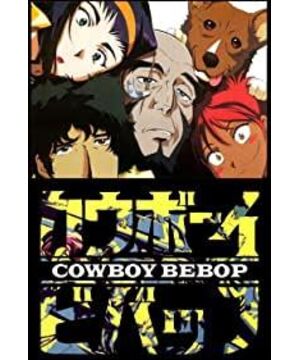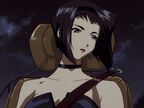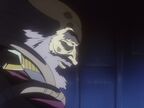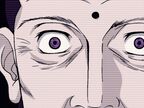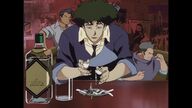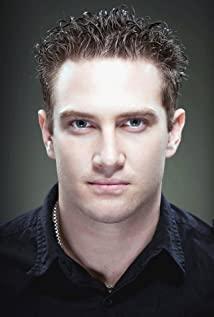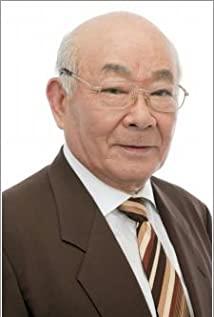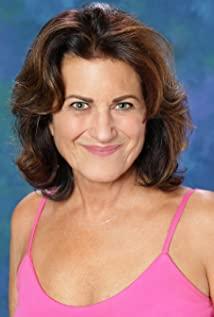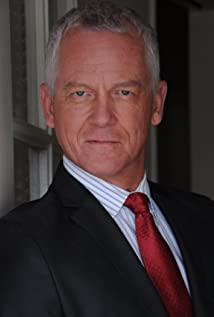On July 3, 2009, he was still at the Japan Expo in Paris, France. Four days later, he appeared at Yoko Kanno's 77Live concert. The opening animation of the concert was directed by him. At this time, Miss Kanno was already single. We don't know what will happen.
"Watanabe Shinichiro: The Melody of Supervision"
Creation and Conception, double C is the melody of supervision.
do~The
most talented person in the animation supervisor for music is Watanabe Shinichiro.
Shinichiro Watanabe was born in Kyoto on May 24, 1965, blood type A, famous animation supervisor, his representative works include "Macros Plus", "Cowboy Bebop", "Samurai Champloo" and so on.
In "Cowboy Bebop", Shinichiro Watanabe combines classic western films with elements of New York film noir, jazz and Hong Kong action films in the 1940s and 1950s. At the same time, most of these stories happen in In the starry sky; in the later work "Samurai Champloo", he mixed Okinawa culture with hip-hop, modern Japanese values, and samurai in the Edo period, creating another refreshing and rich A dynamic new era drama. Watanabe Shinichiro’s animation is like a "comprehensive novel" type like Dostoyevsky's "Brothers Karamazov" but another form of "comprehensive animation" is like a melting pot, in the context of a predetermined worldview. , Drove the mixed and even opposite elements together, and found a new value in the chaotic state, Watanabe also harmonized various types of styles and integrated them to create another new style (new Genre) is well-known, and his grasp of the animation rhythm and the choice of soundtrack is even more interesting.
re~
In 1972, the KISS band was formed by Paul Stanley and Gene Simmons. Three years later, when Watanabe was ten years old, they released an album called "Alive!"; at that time Watanabe had already started to make music. "Experiment".
"Rock n'Roll All Nite" in "Alive!" became KISS’s first hit song. One year later, there was a song called "Detroit Rock City" in their new album "Destroyer". In the original version, the song started with a radio-you can imagine that it should be a car radio, and it played this song "Rock n'Roll All Nite".
The end of the song "Detroit Rock City" was accompanied by a rush of brakes and crashes, echoing the previous car radio, telling a story about KISS fans. This fan unfortunately died in a car accident in order to watch their Live... It sounds a bit like Xiong Tianping made "Matches Paradise" for his brother who was killed in a motorcycle accident. And it is indeed a true story.
Shinichiro Watanabe is very fascinated by "Detroit Rock City". With funding from the Japan Foundation, he had a tour of the United States in 2006, and he came to this song at one of the stops. City-Detroit (Detroit).
At the Detroit Film Festival, he attributed the song and the movie "Dirty Harry" to the root of his first film journey. Perhaps it was the weirdness of that burning city resembling a hell city that made him feel attracted but fearful. Maybe it's just that the origin of the song "Detroit Rock City" in the subconscious touched his young heart, which made him suddenly feel a little sad.
(Besides the topic, Wakasugi Gongde’s "DETROIT METAL CITY" obviously came from this.)
mi~
"I hate the idea of'background' music . I only pay attention to the picture and let the music take the second place as a dispensable." Background', I absolutely can't do this. In my concept, they are equally important. Only the collision between the picture and the music can elevate an animation work to its new heights."
Such a tone...not from Watanabe Shinichiro, but from Shinichi Koichi. In all fairness, taking "Noir" as a lesson, it really is really eager for the soundtrack, and even most of the supervisors are too late. But a bit of a bluffing nouveau riche feeling. Most people who understand music are introverted, and even if they burst out, letting the music go, it should be a kind of enthusiasm. A kind of talent, like writing poetry.
Music is not just a background, even animation is the background of music. It’s not that Watanabe Shinichiro has never done anything like this, but even if the scene is decided during the selection of the soundtrack as in "Cowboy Bebop" Chapter 5 "Ballad of Fallen Angels", the animation scene is based on the soundtrack. The situation did not make people feel a sense of abruptness.
I don't know how Manishita Koichi met music, but for Watanabe Shinichiro, it was a process of fascinating, whether it was the first encounter with KISS or the later encounter with Yoko Kanno.
Before making "Macros Plus", Shinichiro Watanabe didn't actually know Yoko Kanno. At that time, Yoko Kanno's commissions were almost purely commercial. Under the strong recommendation of Victor Entertainment, Watanabe listened to all her previous works, and his deep impression made him expropriate her without any suspense. "Macros Plus" Newage tends to soundtrack-this new style of music between light music and classical music brings the extremely ethereal, mysterious, and ethereal colors to conquer the audience with a strong audiovisual experience. Watanabe Shinichiro is here In such a melody, she debuted in the name of supervisor, and Yoko Kanno, who is known as Morzart in the animation industry, also started her animation soundtrack.
Since then, the soundtrack has always occupied an extremely important position in Watanabe's works. This is invariably related to his idea that "music is a common language in the universe", and Sugawa's music is undoubtedly such a language— -She self-revealed Gabriela Robin's Martian identity on 77Live this year. They all have talents, he perceives, she creates. They were born to be a pair, and they all joined together. In 2006, the famous ACG website IGN gave the honor of "Best Animation Soundtrack in History" to their masterpiece "Cowboy Bebop".
fa~
Knowing people's responsibilities, this is definitely the primary criterion for a good supervision.
Knowing people is not a preference. Because he intends to use hip-hop element music in "Samurai Champloo", and Yoko Kanno is not familiar with this aspect, Watanabe decided to use someone else. Of course, at first, some people suggested that Watanabe let him try to make Yoko Kanno do some hip-hop demos, but Watanabe thought: Let the insiders do it, so that the music will be more imaginative.
Knowing people and doing things, of course, is that Watanabe himself thinks he knows him well. As mentioned before, before getting to know Yoko Kanno, I had to listen to the other party's past works completely. There are many such examples. For example, on the eve of "Samurai Champloo", Watanabe and Nakazawa Kazuto had a long conversation throughout the night, and they experienced a whole night of enthusiastic talks. Nakazawa and Watanabe also collaborated in the previous "Animatrix", but at that time it was only painting and painting supervision. This time, it was a person and painting supervision. It was "Samurai Champloo" that allowed Nakazawa to climb. This miscellaneous family really entered the field of vision of most people-the previous situation was that people may be impressed with the animation in "Kill Bill", but they don't know who made it.
Knowing people, knowing their responsibilities, and understanding each other, you can trust the other party with interesting work that you can't do. When making the theater version of "Cowboy Bebop" "Knockin' on Heaven's Door", Watanabe activated three guest supervisors. They were once in the "Mecha Robe Merolink" (Mecha Hunter Myrolink). As for the OP storytelling supervisor Keiyuki Okuraura who worked with the TVA in "Cowboy Bebop" TVA, the filming supervisor Okamura Tensai, as well as in the "Sky no エスカフローネ" (Holy Sky War) and "Cowboy Bebop" "TVA CCP's action scene supervisor Nakamura Yu. These scenes are all transferred to them because of Watanabe's poor schedule. The other reason is of course that the style of these parts is very different from the main body of the film, but they are quite interesting. He wouldn't hand over boring things to others and evade responsibility. This should be regarded as creating a few job opportunities for the evildoers to use their talents. Or, it's just a kind of interaction and play. And this kind of interaction is quite common in the animation industry. Another example is the "phase difference space" in "Cowboy Bebop" set by Masaharu Kawamori. This is probably one of the most outstanding contributions of this setting maniac. A serious friendship guest appearance after "MACROSS PLUS". Now that "Cowboy Bebop" is mentioned, besides Watanabe Shinichiro, how many people would think of the name Kawamori Masaharu?
Knowing people's responsibilities, of course also knows how to refuse. The producer originally planned to produce the theater version of "Cowboy Bebop" with Ein as the protagonist, because they didn't want the movie to be as solemn as the TVA. In fact, this is mainly the bad wish of the human designer Toshihiro Kawamoto. In the process, he has been trying to increase Ein's role. In fact, in order to make Ein more vivid, he specially bought a Welsh Corgi to come back for observation. I often take it to the working group to show off in Chiguoguo. In this regard, Watanabe just laughed and said that my filming is not an animal story.
Knowing people's responsibilities, and at the same time strictly demanding oneself, only exert one's own unique light and heat. Some people refer to him as the Stanley Kubrick of the animation industry, and experience everything personally, but he only does what he thinks he can master. He cites this example. Clint Eastwood and John Carpenter sometimes compose their own films. They think that should be the effect, but the effect of the soundtrack itself may ultimately be unsatisfactory. So he will not do such a thing, he will give this part of the work to more talented people, this is also a thing full of expectations for him.
The melody that he didn't intend to get involved in himself doesn't mean that he doesn't know what the melody should be, it is also his talent. Nowadays, Shinichiro Watanabe’s comprehension of music is naturally well known by his colleagues, so in addition to supervision, the sideline of music supervision has also developed, "Mind Game", "Genius Party", "ミチコとハッチン" (Taozi and Harkin ), it is this step by step-in fact, except for the two short stories in "Animatrix", the music of all his own supervising works was completed under his instruction.
so~
From "Macross Plus" Newage (Newage), Electronic Music (Techo), to Jazz (Jazz), Blues (Blues) and a combination of a large number of Folk (Folk), Guava (Ballad), Classical, Opera, Rock, Heavy Metal, Samba, Rap, Hip-hop, Bossa Nova, Electronic Music (Techo) and even European and American pop music and other elements of "Cowboy Bebop"-even the title of each episode is a tribute to the classics, and then to "Samurai," which focuses on hip-hop and rap. Champloo", followed by the Latin-style "Miyato and Hakkim" (Taozi and Hajin) who has recently served as a supervisor for Yamamoto Sayo. Another example is the finishing touch of classical music in "Baby Blue".
Don’t talk about the folk music of Okinawa in Chapter 14 of "Samurai Champloo" lasting most of the time of the film, nor talk about the approximately 8,000 songs in his Ipod, and the other 1,600 songs that unfortunately haven’t been included in the movie (it shouldn’t be There is such a problem), Watanabe seems to be chasing more and more melodic phantoms, but at the same time we have also discovered such a regular trend. After the explosion of "Cowboy Bebop", he seems to be doing a good job for himself The action of gradually dividing and categorizing music in the form of animation is like making a documentary of various types of music. For example, in the theatrical version of "Knockin' on Heaven's Door" of "Cowboy Bebop" in 2001, he emphatically described the so-called "Arabesque" atmosphere, which was rarely involved in previous TVA. .
Watanabe Shinichiro, he is such a man, his inner flavor and intuition are far more than what you can see. What you know about his sentiment is only the tip of the iceberg. He believes that the style of the film should be Arabic, and he has set a preliminary tone in private. He will also feel it, but if the feeling of putting himself in is far from what he expected, he will not. Adopt-but usually as expected, this "Cowboy Bebop" movie, he really went to Morocco to feel a bit, and was inspired by it. Putting yourself in, this should be something that many directors and supervisors will do, just like Hayao Miyazaki's early trip to Switzerland, Oshii Mamoru made many trips to Poland for "Avalon", "The Sky Crawlers" and so on. The collision between different cultures can produce very wonderful things, which is probably why many talented and popular directors in Hollywood such as Christopher Nolan, Alex Proyas, Guillermo del Toro and others are foreign legions.
Of course, the supervisors may also be for the satisfaction of selfishness while visiting abroad. I like a place like this, so I came, no matter what, I will create the conditions to reach such a place. It's probably the same idea. Shinichiro Watanabe went to New York to collect material during the production of "Knockin' on Heaven's Door". This story that took place between episodes 22 and 23 of the TVA allowed him to get in touch with the Big Apple-of course the purpose is not here, he It was actually a vinyl record in New York City.
Similarly, in the 2006 US tour, the main reason for picking one of the cities-Houston turned out to be that he thought this was the birthplace of cowboys.
Whether it's Detroit, New York, Houston, or "Africa, Mexico, Sicily, Tijuana,
India, Osaka, Indonesia" in "MUSHROOM HUNTING ", they are all places where his dreams come true.
In an interview with the Texas Daily on Valentine’s Day that year, Shinichiro Watanabe announced three short-term plans and three dreams:
Among them, "Baby Blue" has been presented to us, and the "Cowboy Bebop" he participated in Hollywood The live-action film project was also officially announced at the beginning of this year, and the remaining one is the plan for a new animation series, which is "quite mysterious and very different from the previous works". In addition, he did not disclose more details. , But in general there is still such a speculation: Fortunately, "Baby Blue" in "Genius Party" is a military performance, just like Yuasa Masaaki in "Genius Party" "梦みるキカイ" (Dream Machine ) Like a prelude to "Kaipa" (Hippocampus), after filming future dramas and costume dramas, will the goal this time be modern dramas? Maybe the obsession with making literary and artistic films in my childhood has not been completely wiped out.
In an interview with Yoko Kanno, Watanabe roughly mentioned, "Next time, please feel like Bach, please!" Then, isn't "Baby Blue" a running-in attempt, and "Samurai Champloo" did not do this short film. This time I should take the opportunity to take advantage of the break-in opportunity.
Next time, what new creations and concepts will he bring to us? Stay tuned.
la~
One of the reasons for becoming an animation supervisor, in addition to watching Oshii Mamoru and Miyazaki’s animated films when he was young, and also because of one of his friends (this person is likely to be Masaharu Kawamori, and Shinya Itagaki Isn’t it the suggestion that he was pulled into "Mechanical Basketball"? It’s easier to make animation than to make a live-action movie-he himself thinks so; of course, when he decided to make animation, he was also given to direct a real person Film opportunities, but he finally chose the former.
There are many supervisors who have switched from movies to animation. Oshii Mamoru and Manishita Koichi are the most well-known examples. Watanabe, like them, was also a film youth when they were young. In an interview, Watanabe admitted that he watched a lot of European films when he was young, and probably most of them were mainly literary and artistic, and he was convinced that he would also devote himself to making such films in the future. It was not until many years later that he found out that he had done so far. The things that came out were much more commercial than I originally expected. Out of this and that kind of obsession, he completed the short film "Baby Blue" in "Genius Party", which means his original dream.
When someone asked if he would continue to do the sequel to "Cowboy Bebop," or if Spike died in the end, he said, no, maybe, because only in this way can those spirits last forever. The dream is a Schrodinger cat. What I have done for the original dream, we can imagine what he would say, and each of us has done what for our dream. Therefore, we should be relieved. The sound of "Baby Blue" at the end of Chopin's "Farewell" (Chopin "Tristesse"), for him, does it mean that he finally admits and completely affirms himself now, and let the avatar of the literary soul follow the wind? Passed away? Or, the beginning of another journey? Maybe he will become Xin Haicheng, and he may be more famous than now, perhaps even more famous than Xin Haicheng. Maybe he had thoughts like this before, maybe he didn't even know who Xin Haicheng was. But in short, are there any benefits?
On the other hand, not to mention literature and art, everyone in the eyes of others and self-definition must be different from time to time. Before making "Cowboy Bebop," everyone around Watanabe thought that he would most likely make some dark-toned movies, but the fact is that the animations he made are not lacking in motion. Although there are sad emotions from time to time, but The overall tone is always bright, humorous, and positive. You can’t see yourself until everything is done, and you can only discover your talents when you actually start making the film. In the process of creating, you can always dig out your unknown talents, which may be yourself. Don't know the talent. Then why you are for you. Being able to be yourself may be the real benefit of this life, because sometimes what you originally expected of yourself is actually just the shadow of others.
Compared to making live-action movies, making animation requires more coordination skills. In the production of live-action movies, the scheduling of some big scenes requires considerable effort from the director, but the animation supervision starts with the construction of almost every scene, and then arranges and dispatches various elements in the scene. For animation, the theme may not reach the depth of making a movie, but the process is definitely much more complicated than that of a movie. This situation must have been ignorant before Watanabe started his career. In 1984, when he was nineteen years old, when he watched two theatrical animations that were released that year-Oshii Mamoru's "Fortune Star Boy" 2: After "Beautiful Dreamer" and "Nausicaa" by Hayao Miyazaki, the impact of "movies can also be made into this form" made him realize the new world of animation. At the age of 20, he entered Sunrise with this mood, and he didn't mind what kind of "movie" he was doing. In this way, he worked at the bottom of the animation company for eight years in production and several "shows". After his drills, he finally began to challenge the position of "supervisor".
Therefore, Watanabe Shinichiro’s entry into the animation industry is not an occasional one. Obviously, it is no better than the boring and unemployed Mamoru Oshii who bumped into the recruitment notice of Dragon Son on a telephone pole, but he had to compromise and enter the animation industry instead of being unable to make a difference in movies. It takes a lot of planning to really go down.
si~
The creation should be casual enough, so that there will be more opportunities for surprises and surprises, so that the work is not fixed and boring. The birth of "Cowboy Bebop" may be a casual beginning. At first, Shinichiro Watanabe told the story that there must be a spaceship in the story, so he submitted a proposal, and then he got the reply: as long as there is a spaceship. , We don’t interfere with others. So, Watanabe Shinichiro finally took the project down.
Yoko Kanno's overall impression of the "Cowboy Bebop" production team is that everyone is relaxed... For example, they sometimes do it lazily together. Whether it's animation, commercials or TV series, they always take it very seriously and argue about it... "This scene should be like this..."... "No, no, the heroine shouldn't say such things!" My impression. But... they look really lazy, just like the tone of their animation.
This is basically the situation. It is very casual. For example, in the theater version of "Cowboy Bebop" "Knockin' on Heaven's Door", when Keiko Nobumoto wrote about the shop robbery, she couldn't find it at all. When it was time for inspiration, they decided to find a real actor as a model. They found Renji Ishibashi half-jokingly. Unexpectedly, the other party agreed, so the character "Rengie" was born. Renji Ishibashi is a strong veteran of the Japanese film and television industry. He once won the Best Supporting Actor Award at the 14th Japan Academy Awards for his outstanding performance in "Ruroin Street"; Ishibashi’s father, Ryunosuke Tsukigata, was Toei's signature villain actor may have inherited his father's talents. Ishibashi Renji is also very good at playing negative roles. He has played many criminals, villains, and underworld people, and can portray villains with abnormal personalities. Therefore, Watanabe's approach to him was not entirely random and without reason.
Other examples, for example, many of the soundtracks in "Samurai Champloo" are actually played on the spot. Watanabe mentioned that the films that have had a deep influence on "Samurai Champloo" include "Zatoshi" (it should be Kitano Takeshi, although there are more movies named "Zatoshi"), in addition to Bruce Lee's "Dirty Harry" and "Dirty Harry", etc.-"Dirty Harry" can be said to have influenced a group of animators. Umezu Yasumi has appeared in "Mezzo Forte" such as "Dirty Barry". Tribute poster; the other influence is naturally chiropractic. During the production of "Samurai Champloo", Watanabe often visited a Chinese chiropractor who would tell him some traditional Chinese cultural stories during the massage process, such as the concept of "qi"-in fact, Watanabe In "Samurai Champloo", a story with this concept as the theme was created.
There are also action designs for such casual materials, such as the unrealistic fighting action designs in "Samurai Champloo". The twisting illusion should be like dancing Capoeira (Capoeira, a Brazilian dance that combines folk dances and self-defense movements from Africa), although in fact Watanabe is a breakdancing dance This set of movements was designed for the original shape, and it was not until later that I saw the Capoeira dance that I realized that the two were so similar. Sometimes this kind of randomness comes from natural instinct, which makes people feel that they are doing it right without knowing it.
Although people like Watanabe breathe out in the world, he does come from nature.
"I will not'declare' anything. I do not make movies to instill certain ideas into the audience. Movies are a very natural thing that reflects our feelings about an era. We are entertained, yes, but they are also It records our way of thinking, and some emotions that we can’t express. I think that movies as a medium should exist in this form. I feel that people can unknowingly get that emotion in my movies. I am happy.” Watanabe said when it was mentioned whether the virus in the theater version of "Cowboy Bebop" alludes to HIV, and whether there are any accusations of social insensitivity to violence in the film, Watanabe said.
Directors who are not deliberate are good directors. They are neither literary nor artistic, nor do they have anything to do with pretense. They are just documentaries that record a kind of moving. "Primitive texture, natural", there is calm air and thunderous weather, natural also guarantees enough passion, just like the difference between cold jazz and roaring jazz, just like we can understand "Cowboy Bebop" as "Cowboy Bebop" "A Life of Cowboy in The Bebop Jazz" (A Life of Cowboy in The Bebop Jazz).
Roaring cowboy, roaring cowboy, this is Shinichiro Watanabe.
do~
When someone asked what kind of movie you would make if the budget was not a problem, he laughed and said that I would make a "movie" where I fled to a small island in the south.
Just like a cowboy who never looks back when riding a horse towards his goal, and just like the theme of "encounter and separation" in many of his works, his description of his ideal life is of course nothing more than this.
Naturally, what he made may not be a movie, but a way of life.
He is a man with sunglasses, but we don’t know if those sunglasses also have myopia function.
Published in "
Xianshiyan " VOL 3 in my last blog post on aggtalk, history has become history itself, mourning for mourning has died.
View more about Cowboy Bebop reviews


